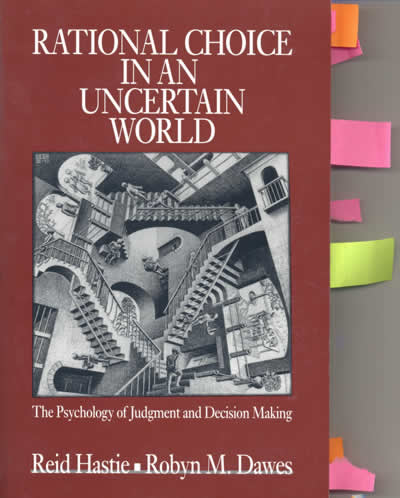Strategies for decision making
 Subscribe to Decision Science News by Email (one email per week, easy unsubscribe)
Subscribe to Decision Science News by Email (one email per week, easy unsubscribe)
MAJOR CHOICE STRATEGIES

The editor’s somewhat annotated copy of Hastie & Dawes
Reid Hastie and Robyn M. Dawes, in their classic Rational Choice in an Uncertain World (pp. 232-234), outline some “major choice strategies,” stemming from several schools including the Heuristics and Biases, Adaptive Decision Maker, and Fast and Frugal research programs:
| Strategy: DOMINANCE | ||||
| Mental Effort | Compensatory vs. Noncompensatory? | Whole vs. Part | Exhausive? | |
| LOW | NON-COMPENSATORY | ALTERNATIVE | YES | |
| “Search for an alternative that is at least as good as every other alternative on all important attributes and choose it or find an alternative that is worse than any other alternative on all attributes and throw it out of the choice set.” | ||||
 |
||||
| Strategy: ADDITIVE LINEAR (Multi-Attribute Utility Theory) | ||||
| Mental Effort | Compensatory vs. Noncompensatory? | Whole vs. Part | Exhausive? | |
| V. HIGH | COMPENSATORY | ALTERNATIVE | YES | |
| “Weight all the attributes by their importance (with reference to the current goals of the decision maker). Then consider each alternative one at a time and calculate a global utility by valuing each attribute, weighting it by its importance, and adding up the weighted values.” | ||||
 |
||||
| Strategy: ADDITIVE DIFFERENCE | ||||
| Mental Effort | Compensatory vs. Noncompensatory? | Whole vs. Part | Exhausive? | |
| V. HIGH | COMPENSATORY | ATTRIBUTE | YES | |
| “Consider two alternatives at a time; compare attribute by attribute, estimating the difference between the two alternatives; and sum up the differences across the attributes to provide a single overall difference score across all attributes for that pair. Carry the winner of this comparison over to the next viable alternative and make the same comparison. At the end of this process, the best alternative is the one that has ‘won’ all the pairwise comparisons.” | ||||
 |
||||
| Strategy: SATISFICING (CONJUNCTIVE) | ||||
| Mental Effort | Compensatory vs. Noncompensatory? | Whole vs. Part | Exhausive? | |
| LOW | NON-COMPENSATORY | ALTERNATIVE | NO | |
| “First set ‘acceptability’ cutoff points on all important attributes; then look for the first alternative that is at least as good as the cutoff values on all important attributes or use the strategy to select a set of good-enough alternatives (all above the cutoff points) for further consideration.” | ||||
 |
||||
| Strategy: DISJUNCTIVE | ||||
| Mental Effort | Compensatory vs. Noncompensatory? | Whole vs. Part | Exhausive? | |
| LOW | NON-COMPENSATORY | ALTERNATIVE | NO | |
| “First, set ‘acceptability’ cutoff points on the important attributes; then look for the first alternative that is at least as good as the cutoff value on any attribute or use the strategy to select a set of alternatives that are very good on at least one dimension for further consideration.” | ||||
 |
||||
| Strategy: LEXICOGRAPHIC (AND TAKE-THE-BEST) | ||||
| Mental Effort | Compensatory vs. Noncompensatory? | Whole vs. Part | Exhausive? | |
| MEDIUM | NON-COMPENSATORY | ATTRIBUTE | NO | |
| “First, review the attributes and pick the one most important attribute; then choose the beest alternative on that attribute. If there are several “winners” on the first attribute, go on to the next most important attribute and pick the best remaining alternative(s) on that attribute. Repeat until only one alternative is left … [Similar to the] take-the-best fast-and-frugal heuristic (successful in choice and judgment environments that reflect the distributions of alternatives and attribute values in real, everyday environments). The only adjustment to our description would be to substitute the word ‘validity’ (predictive accuracy) for ‘importance’; order the attributes considered by their past validity in discriminating between good and bad alternatives.” | ||||
 |
||||
| Strategy: ELIMINATION BY ASPECTS | ||||
| Mental Effort | Compensatory vs. Noncompensatory? | Whole vs. Part | Exhausive? | |
| MEDIUM | NON-COMPENSATORY | ATTRIBUTE | NO | |
| “Pick the first attribute that is salient and set a cutoff ‘acceptability’ point on that attribute. Throw out all alternatives that are below the cutoff on that one attribute. Then pick the next most attention-getting attribute, set an ‘acceptability’ cutoff on that attribute, and again throw out all alternatives that are below the cutoff. Repeat until only one alternative is left.” | ||||
 |
||||
| Strategy: RECOGNITION HEURISTIC | ||||
| Mental Effort | Compensatory vs. Noncompensatory? | Whole vs. Part | Exhausive? | |
| LOW | NON-COMPENSATORY | ALTERNATIVE | NO | |
| “In some choices, people are so poorly informed about the alternatives that they simply rely on ‘name recognition.’ They choose the first alternative that they recognize … in many realistic choices and judgments the ‘fast and frugal’ recognition choice heuristic behaves surprisingly well.” | ||||
 |
||||
Source: Hastie, Reid & Dawes, Robyn M. (2001). Rational choice in an uncertain world. Sage: Thousand Oaks, CA, pp. 232-234.
About the Authors:
REID HASTIE

Reid Hastie is a Professor of Behavioral Science on the faculty of the Graduate School of Business in the Center for Decision Research at the University of Chicago. His primary research interests are in the areas of judgment and decision making (legal, managerial, medical, engineering, and personal), memory and cognition, and social psychology. He is best known for his research on legal decision making (Social Psychology in Court [with Michael Saks]; Inside the Jury [with Steven Penrod and Nancy Pennington]; and Inside the Juror [edited]) and on social memory and judgment processes (Person Memory: The Cognitive Basis of Social Perception [several co-authors]). Currently he is studying: the role of explanations in category concept representations (including the effects on category classification, deductive, and inductive inferences); civil jury decision making; the role of frequency information in probability judgments; and the psychology of reading statistical graphs and maps.
ROBYN M. DAWES

Robyn Dawes is the Charles J. Queenan, Jr. University Professor Ph.D.: University of Michigan Department Member Since: 1985 at the Department of Social & Decision Sciences at Carnegie Mellon University. His research interests spans five areas: intuitive expertise, human cooperation, retrospective memory, methodology and United States AIDS policy. He states, “I write journal articles and books because I believe the information they contain could be valuable — at least on a “perhaps, maybe” basis. I have never written anything with the expectation that it will sell, or become a “citation classic” (although one of my articles has). I believe that in American culture we are obsessed with outcomes rather than with behaving in ways that tend to bring about the best expected outcomes, while “time and chance” play a very important role. […] Some of my clinical colleagues claim that feelings are not understood until they can be put into words. My own view is that every translation of a feeling, thought, idea or mathematical form into words involves at least a small element of automatic distortion, often a much larger element.”

